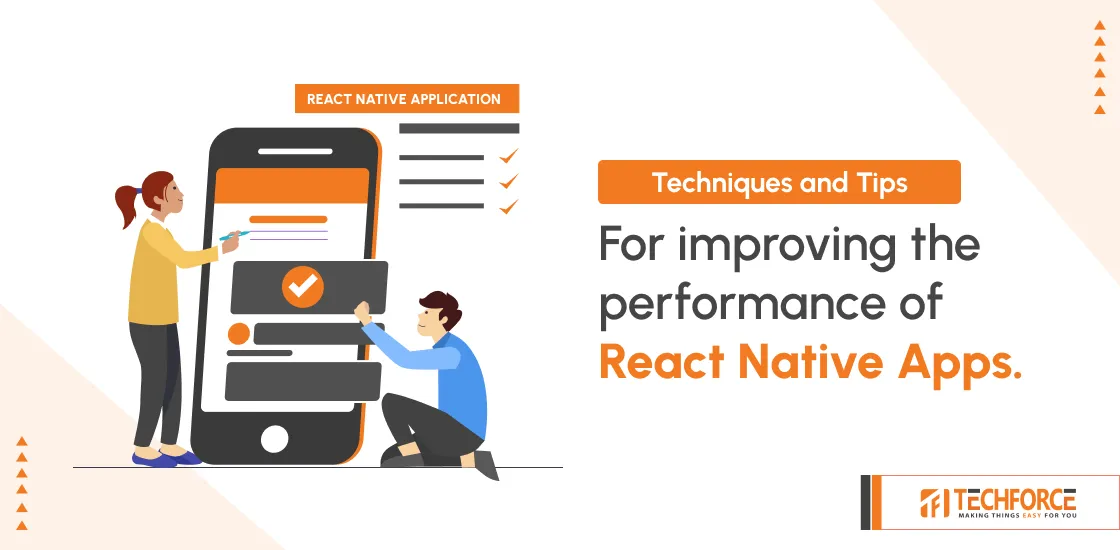Techniques and tips for improving the performance of React Native apps
React Native has gained immense popularity as a framework for building cross-platform mobile applications due to its ability to use the same codebase for both iOS and Android. However, performance optimization is crucial to ensure a smooth user experience. This blog covers some of the best techniques and tips for improving the performance of React Native apps.
Optimize Image Loading
Images often consume a significant amount of resources. Here are some tips to optimize image loading:
- Use appropriate image sizes : Always use images that are appropriately sized for different screen resolutions. Loading a large image and resizing it in the app can slow down performance.
- Cache images : Utilize libraries like react-native-fast-image to cache images and reduce loading times.
- Optimize image formats : Use efficient image formats like JPEG for photos and PNG for graphics with fewer colors.
import FastImage from 'react-native-fast-image';
const OptimizedImage = () => (
<FastImage
style={{ width: 200, height: 200 }}
source={{
uri: 'https://example.com/image.jpg',
priority: FastImage.priority.normal,
}}
resizeMode={FastImage.resizeMode.contain}
/> );
Use FlatList for Rendering Large Lists
When dealing with large lists, using FlatList instead of ScrollView can drastically improve performance. FlatList only renders items that are currently visible on the screen, reducing memory consumption and improving scrolling performance.
import React, { useEffect } from 'react';
import { FlatList } from 'react-native';
const MyList = ({ data }) => {
const renderItem = ({ item }) => (
<ListItem item={item} />
);
return (
<FlatList
data={data}
renderItem={renderItem}
keyExtractor={(item) => item.id}
/>
);
};
Optimize Rendering with Pure Component and Memo
Unnecessary re-renders can degrade performance. Use Pure Component or React.memo to prevent unnecessary re-renders of components when their props or state haven’t changed.
- If you’re using class components, extend Pure Component instead of Component. Pure Component implements should Component Update with a shallow prop and state comparison.
import React, { PureComponent } from 'react';
class MyPureComponent extends PureComponent {
render() {
// Component logic
} }
- React.memo is a higher-order component that can significantly improve performance by memoizing functional components. It prevents unnecessary re-renders when the props haven’t changed.
import React from 'react';
const MyComponent = React.memo(({ data }) => {
// Component logic
return (
// JSX
);
});
Implement useCallback for Memoized Callbacks
The useCallback hook in React is used to create memoized versions of functions. It helps avoid unnecessary re-creations of functions across re-renders, which can optimize performance, particularly when passing callbacks to child components.
import React, { useCallback } from 'react';
const ParentComponent = () => {
const memoizedCallback = useCallback(() => {
// Callback logic
}, [/* dependencies */]);
return <ChildComponent onSomeEvent={memoizedCallback} />;
};
export default MyComponent;
Use Hermes Engine
Hermes is an open-source JavaScript engine optimized for running React Native. It can significantly improve the startup time, memory usage, and overall performance of your app.
To enable Hermes, update your android/app/build.gradle file:
project.ext.react = [
enableHermes: true // Enable Hermes
]
Optimize Navigation
Efficient navigation is crucial for a seamless user experience in React Native apps. By optimizing navigation, you can reduce the initial load time and ensure smooth transitions between screens. Using React Navigation, a popular library, you can leverage features like lazy loading and screen detachment to enhance performance.
- Enable Lazy Loading: –
Lazy loading ensures that screens are only loaded when they are needed, which can significantly reduce the initial load time of your app.
import React, { Suspense, lazy } from 'react';
import { NavigationContainer } from '@react-navigation/native';
import { createStackNavigator } from '@react-navigation/stack';
const Stack = createStackNavigator();
// Lazy load the screens
const HomeScreen = lazy(() => import('./screens/HomeScreen'));
const DetailsScreen = lazy(() => import('./screens/DetailsScreen'));
const App = () => {
return (
<NavigationContainer>
<Stack.Navigator>
<Stack.Screen
name="Home"
options={{ title: 'Home' }} >
{props => (
<Suspense fallback={<LoadingScreen />}>
<HomeScreen {...props} />
</Suspense>
)}
</Stack.Screen>
<Stack.Screen
name="Details"
options={{ title: 'Details' }}
>
{props => (
<Suspense fallback={<LoadingScreen />}>
<DetailsScreen {...props} />
</Suspense>
)}
</Stack.Screen>
</Stack.Navigator>
</NavigationContainer>
);
};
const LoadingScreen = () => (
<View style={styles.loadingContainer}>
<ActivityIndicator size="large" color="#0000ff" />
</View>
);
export default App;
Use InteractionManager for Expensive Operations
The InteractionManager in React Native is a utility that helps defer expensive operations until interactions and animations are complete. It allows you to ensure that costly tasks do not interfere with smooth user interactions.
import { InteractionManager } from 'react-native';
const MyComponent = () => {
useEffect(() => {
InteractionManager.runAfterInteractions(() => {
// Run expensive operation here
});
}, []);
// Component logic
};
Implement Memoization for Expensive Computations
Memoization is a technique used to optimize the performance of expensive functions by caching their results. In React, the useMemo hook can be used to memoize values computed from expensive functions, ensuring that the function is only re-computed when its dependencies change.
import React, { useEffect, useMemo } from 'react';
import { View } from 'react-native';
const MyComponent = ({ data }) => {
const expensiveResult = useMemo(() => {
// Expensive computation
return someExpensiveOperation(data);
}, [data]);
return (
<View>
<Text>Expensive Result: {expensiveResult}</Text>
</View>
); // Use expensiveResult in your component };
Optimize State Management
Efficient state management is crucial for improving the performance of your app. Properly managing and structuring your state can prevent unnecessary re-renders and simplify state updates.
- Use Context API or Libraries like Redux
Using the Context API or state management libraries like Redux helps in organizing state in a way that minimizes unnecessary re-renders.
import React, { createContext, useContext, useReducer } from 'react';
import { View, Text, Button, StyleSheet } from 'react-native';
// Define initial state
const initialState = {
count: 0,
};
// Define reducer
const reducer = (state, action) => {
switch (action.type) {
case 'INCREMENT':
return { …state, count: state.count + 1 };
case 'DECREMENT':
return { …state, count: state.count - 1 };
default:
return state;
}
};
// Create context
const AppContext = createContext();
const AppProvider = ({ children }) => {
const [state, dispatch] = useReducer(reducer, initialState);
return (
<AppContext.Provider value={{ state, dispatch }}>
{children}
</AppContext.Provider>
);
};
// Use context in a component
const Counter = () => {
const { state, dispatch } = useContext(AppContext);
return (
<View style={styles.container}>
<Text style={styles.countText}>Count: {state.count}</Text>
<Button title="Increment" onPress={() => dispatch({ type: 'INCREMENT' })} />
<Button title="Decrement" onPress={() => dispatch({ type: 'DECREMENT' })} />
</View>
);
};
const App = () => (
<AppProvider>
<Counter />
</AppProvider>
);
const styles = StyleSheet.create({
container: {
flex: 1,
justifyContent: 'center',
alignItems: 'center',
padding: 20,
},
countText: {
fontSize: 24,
marginBottom: 20,
},
});
export default App;
- Avoid Deep Nesting
Keeping your state flat and avoiding deeply nested objects simplifies state updates and reduces complexity, which can improve performance.
// Before: deeply nested state
const initialState = {
user: {
profile: {
name: 'John',
age: 30,
address: {
city: 'New York',
zip: '10001',
},
},
},
};
// After: flattened state
const initialState = {
userName: 'John',
userAge: 30,
userCity: 'New York',
userZip: '10001',
};
Profile Your App
Profiling your React Native app helps identify performance bottlenecks, memory leaks, and areas for optimization. Here’s a brief guide on using popular profiling tools:
React Native Performance Monitor
React Native includes a built-in performance monitor that provides insights into the frame rate, JS thread activity, and more.
To enable it:
- Shake your device or press Cmd+D (iOS) / Cmd+M (Android) to open the developer menu.
- Select “Show Perf Monitor.”
Flipper
Flipper is a desktop debugging tool that integrates with React Native and offers extensive performance profiling capabilities.
To use Flipper:
1. Install Flipper: Download and install Flipper from Flipper’s website.
2. Add Flipper to your React Native project: Follow the React Native Flipper setup guide.
Features to use:
· React DevTools: Inspect component hierarchies and performance.
· Network Inspector: Analyze network requests and responses.
· Profiler: Track performance and identify slow components.
Chrome DevTools
Chrome DevTools can be used for profiling JavaScript performance.
To use Chrome DevTools:
1. Enable Debugging: Open your app in a simulator/emulator and enable remote debugging from the developer menu.
2. Open DevTools: In Chrome, navigate to chrome://inspect and open DevTools.
· Performance Tab: Record and analyze performance profiles to identify slow functions.
· Memory Tab: Check for memory leaks and evaluate memory usage patterns.
Conclusion:
Implementing these techniques and tips can significantly improve the performance of your React Native apps. Remember that optimization is an ongoing process, and it’s essential to profile and measure your app’s performance regularly. Use tools like the React Native Debugger and the Performance Monitor to identify bottlenecks and areas for improvement.
By focusing on these performance optimizations, you can create React Native apps that are not only cross-platform but also fast, responsive, and provide excellent user experience across different devices and operating systems.
 Rahul Soni
26 Jul 2024
Rahul Soni
26 Jul 2024
 US +1 (630) 296 6606
US +1 (630) 296 6606
 India +91 (79) 48904529
India +91 (79) 48904529
 Poland +48 (730) 059 665
Poland +48 (730) 059 665
 reach@techforceglobal.com
reach@techforceglobal.com
 +1 630 303 7389
+1 630 303 7389

 Calendly
Calendly
 LinkedIn
LinkedIn
 Whatsapp
Whatsapp
 Fintech
Fintech
 Education
Education
 Ecommerce
Ecommerce
 Healthcare
Healthcare
 Travel and Hospitality
Travel and Hospitality
 Public Sector
Public Sector




